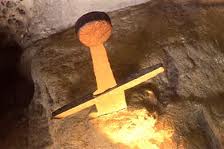
![]()
Index • |
Welcome • |
About
Us • |
21st Century • The Future |
World
Travel • Destinations |
Reviews • Books & Film |
Dreamscapes • Original Fiction |
Opinion
& Lifestyle • Politics & Living |
Film
Space • Movies in depth |
Kid's
Books • Reviews & stories |
Dreamscapes Two • More Original Fiction |
The International Writers Magazine: Myths and Legends
The real Sword in the Stone is in Tuscany
• Zara Nelson
Research often leads down unexpected and fascinating roads. I was busy writing material on the best wedding locations in Tuscany for a local magazine, when I was sidetracked by a mysterious Tuscan enigma that has remained unresolved for 800 years. A mysterious sword in a stone - but it is not in Camelot, and not even in Britain.
It belonged to Galgano Guidotti, a nobleman born in Chiusdino (about 30km southwest of Siena) in 1148. In his early thirties he had a vision in which he was ordered by an archangel to build a round chapel at nearby Montesiepi. Despite the best efforts of his family to persuade him otherwise, Galgano galloped off to Montesiepi where he plunged his sword into a rock. The sword cut through the stone like a knife through butter, and stuck there, forming a cross. Galgano became a sensation, pilgrims flocked to Montesiepi, but he didn't actually have time to build his chapel as he died just one year later in 1181. He was canonised in record time in 1185, by Pope Lucius III.
It has long been assumed that the Montesiepi sword in the stone is a fake - a medieval recreation of the Arthurian legend - but is it possible that the truth is really the other way round, that St Galgano and his sword are actually the origin of parts of the myth of King Arthur and the Knights of the Round Table? Italian medieval historian and Templar expert Mario Moiraghi thinks so - he claims that the name 'Galgano' may have been corrupted into 'Galvano', the Italian name for Gawain, as the sword story spread across medieval Europe. What is certain is that Galvano or Gawain – known as 'the first Knight' - played an important role in the early medieval tales of the round table. In Chretien de Troyes' 'Perceval, the story of the Grail', which was completed around the time of Galgano's canonisation, it is Gawain and not Arthur who carries Excalibur, which is described as “the finest sword there was, which sliced through iron as through wood”. Just as Galgano's sword sliced through stone?
More mysteries surround the connection between Galgano and the Arthurian legends. Was the Round Table really inspired by the shape of the Round Chapel at Montesiepi that was built over Galgano's sword in the stone after his death? Some believe that this Round Chapel is actually the resting place of the Holy Grail itself – the chapel's form certainly resembles an upside down cup or chalice, and local legend has always whispered about a secret cavity below the chapel, that can be accessed by moving one particular stone on the floor.
There is another important, and surprising, link between Arthur and Italy. The cathedral in Modena houses what is possibly the earliest monumental sculpture to feature the Arthurian legend. The cathedral's north portal carries an archivolt with high relief carvings of figures with inscriptions that clearly identify them as Arthurian characters. The Modena Archivolt has been dated between 1120 and 1140, a few years before Galgano's birth – proving that the stories of King Arthur and his knights were already well known in this area of Italy at the time, stories considered important enough to be given such a prominent and meaningful position on one of the most important Romanesque buildings in Europe. Modena Cathedral was consecrated in 1184 – just after Galgano's death, and one year before he himself was canonised. And who consecrated the cathedral? Pope Lucius III, the same pope who made Galgano a saint. Maybe that's more than just a coincidence.
What about Galgano's sword itself, the hard evidence in the case? Only the hilt and a couple of inches of blade are visible. The theory that it predates the Athurian sword in the stone has been backed up by tests carried out on the Tuscan sword at the University of Pavia. It is made of non-alloy metal that dates to the 12th century, and the style is compatible with that era too. If that really is the case, then it is some decades older than the first literary reference to Arthur's sword in the stone, and the theory that Galgano's miracle was absorbed into the Arthurian legend as it was rediffused throughout Europe changes from romantic possibility to concrete probability. Researchers who carried out the tests on the sword also claim that there really does seem to be a cavity below the rock...but for the moment, only Galgano knows what lies beneath.© Zara Nelson May 1st 2011
More Life stories
zara.nelson@gmail.com
www.zaranelson.net
http://www.thetuscanmagazine.com/blog/?cat=11

